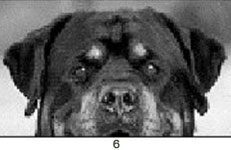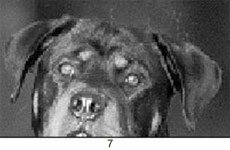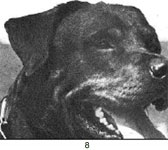
The Priority Of Breed Type In The Rottweiler Text and drawings by Steve Wolfson, picture Hermeline/aniwa
The Head
There’s a determining element which one should not forget to mention in this article about the Rottweiler, and it’s the head, the appreciation of which can vary depending on the judges. Below are the heads of two great champions from the last 3 years, and yet they are quite different. This may be surprising for the neophyte, as this is also true in the native country of the breed. On the left, the Klubsieger 2000, Arko, a dog which won almost everything that year, and on the right Mambo Von Der Crossener Ranch, the most titled dogs in the last 5 months in German shows, and which may very likely be the Winner of the next ADRK Klubsieger cha...
The breed standard is somewhat vague in its description of certain areas and certainly does not provide us with examples to illustrate its meaning. What exactly is correct body type, what is correct head structure and bone substance?
We can observe this vagueness occurring in the great variance of body types, and markings, in the show ring and out. I believe that the main reason for this inconsistency is incomplete knowledge of what correct type is on the part of many breeders and exhibitors. Since the head, for me is the "hallmark of the breed" I feel that is the best place to start.
What is correct head type? In order to answer that question we must first study the headpiece in its component parts. The head can be broken down into 8 major segments and two subcategories. I will list them categorically from highest priority to lowest. Please note for the purpose of this article I refer to the male headpiece. The only difference between the male headpiece and the female headpiece should be the depth of the stop, in the male it is more pronounced.
1. The Skull
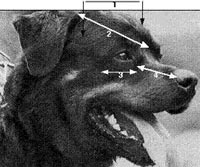 The top of the skull should be broad between the ears giving the impression of masculinity and power. Correct male heads have a "character" to them, usually expressed in the form of sharp masculine angles. They may even have a certain coarseness to them yet not so coarse as to look like a Mastiff or Bulldog, conversely the feminine head may have slightly softer angles. There should be depth in the muscle mass, which lies on top of the skull. The top skull must also have a slight arch from stop to occipital ridge (Arrow 2) and from ear to ear (Arrow 1). The skull is 60% of the length from tip of nose to occipital ridge.
The stop should be well pronounced in the male head. The zygomatic arch (Arrow 3) is also strong, giving structural support to the upper jawbone and lower portion of eye.
The top of the skull should be broad between the ears giving the impression of masculinity and power. Correct male heads have a "character" to them, usually expressed in the form of sharp masculine angles. They may even have a certain coarseness to them yet not so coarse as to look like a Mastiff or Bulldog, conversely the feminine head may have slightly softer angles. There should be depth in the muscle mass, which lies on top of the skull. The top skull must also have a slight arch from stop to occipital ridge (Arrow 2) and from ear to ear (Arrow 1). The skull is 60% of the length from tip of nose to occipital ridge.
The stop should be well pronounced in the male head. The zygomatic arch (Arrow 3) is also strong, giving structural support to the upper jawbone and lower portion of eye.
Not typical head type problems :
1: Too much dome for the top skull, should not look like the apple type skull of the Cocker Spaniel
2: Too coarse "Bull dog" or Mastiff like
3: Too fine or feminine, lacking in masculinity, conversely bitches should not look like dogs
4. Disproportionate head, too small for body size, conversely too large for body size
2. Muzzle
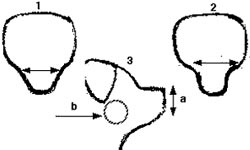 The male muzzle is straight (see head, previous picture - Arrow 4) with no bumps or sloping of the nostril (Roman nose) and should give the impression of power and strength (the same for the female muzzle). To give this impression of power it must be broad at the base producing a thick, wedge shaped triangle, tapering slightly towards the nostril.
The nostrils are always broad, permitting good air passage to cool the dog off during respiration and corresponding with its broad muzzle in depth and width. In figure 1, the muzzle is of correct length and width. In figure 2, the muzzle is of correct length, but not correct in the width at the base. Many Rottweilers we see today unfortunately fall into figure 2 category. Care must be taken with breeding partners to insure the muzzle does not lengthen and become houndy or snipey. This area requires careful consideration on the part of breeders, since it is a type trait hard won, and easily lost.
In figure 3, the muzzle is seen from the side presenting good depth from top of muzzle to the bottom of the lower jaw (Arrow a). If the bite shifts and becomes overshot, the lower jaw appears shallow. If undershot the lower jaw appears to protrude forward. Arrow b is the location of the masseter muscle. This muscle should have some thickness to it but not so thick as to look like the Pit bull masseter.
The male muzzle is straight (see head, previous picture - Arrow 4) with no bumps or sloping of the nostril (Roman nose) and should give the impression of power and strength (the same for the female muzzle). To give this impression of power it must be broad at the base producing a thick, wedge shaped triangle, tapering slightly towards the nostril.
The nostrils are always broad, permitting good air passage to cool the dog off during respiration and corresponding with its broad muzzle in depth and width. In figure 1, the muzzle is of correct length and width. In figure 2, the muzzle is of correct length, but not correct in the width at the base. Many Rottweilers we see today unfortunately fall into figure 2 category. Care must be taken with breeding partners to insure the muzzle does not lengthen and become houndy or snipey. This area requires careful consideration on the part of breeders, since it is a type trait hard won, and easily lost.
In figure 3, the muzzle is seen from the side presenting good depth from top of muzzle to the bottom of the lower jaw (Arrow a). If the bite shifts and becomes overshot, the lower jaw appears shallow. If undershot the lower jaw appears to protrude forward. Arrow b is the location of the masseter muscle. This muscle should have some thickness to it but not so thick as to look like the Pit bull masseter.
3. Eyes
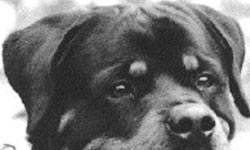 The colour of the eyes should always be as dark as possible, with 1 at the best. It is not so much a functionality reason, since the eyes can work either light or dark, but an all important type trait. As the eye colour gets lighter it softens the appearance of the gaze, diminishing the fearlessness of Rottweiler expression.
Another factor in striving to keep the eye colour dark is the difficulty in maintaining it once light eyes are introduced into the bloodline. Interestingly, the German eye chart allows a range of 1 a-5b, however, to be more precise one can often observe shades of eye colour in between these numbers. Therefore half shades are also possible. Example 1 A 1/2, 2 B 1/2, etc.
The colour of the eyes should always be as dark as possible, with 1 at the best. It is not so much a functionality reason, since the eyes can work either light or dark, but an all important type trait. As the eye colour gets lighter it softens the appearance of the gaze, diminishing the fearlessness of Rottweiler expression.
Another factor in striving to keep the eye colour dark is the difficulty in maintaining it once light eyes are introduced into the bloodline. Interestingly, the German eye chart allows a range of 1 a-5b, however, to be more precise one can often observe shades of eye colour in between these numbers. Therefore half shades are also possible. Example 1 A 1/2, 2 B 1/2, etc.
Shape and placement of eyes (subcategory):
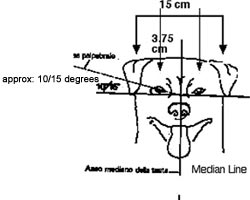 The shape of the eye should always be almond with tight fitting lids. Round eyes are a fault. Hairless lids are a fault and an indication of a problem. The distance of the eyes from each other and their location on the head is also of importance. The eyes should lie at a 10-15 degree angle above the bridge of the nose. Best set wide apart.
Below is a chart with an approximation of the correct proportionate distance which the eyes should be set apart. This chart is taken from Dr.Carla Lensi's book on the Rottweiler. She marks the angle at which the eyes should sit in it's placement above the bridge of the nose (approx. 10-15 degrees). The eyes ideally should also be set 1/4 the distance of the width of the top skull from ear to ear. For example if the top skull measures 15 cm across then the eye should sit 3.75 cm from the centre of the stop.
The shape of the eye should always be almond with tight fitting lids. Round eyes are a fault. Hairless lids are a fault and an indication of a problem. The distance of the eyes from each other and their location on the head is also of importance. The eyes should lie at a 10-15 degree angle above the bridge of the nose. Best set wide apart.
Below is a chart with an approximation of the correct proportionate distance which the eyes should be set apart. This chart is taken from Dr.Carla Lensi's book on the Rottweiler. She marks the angle at which the eyes should sit in it's placement above the bridge of the nose (approx. 10-15 degrees). The eyes ideally should also be set 1/4 the distance of the width of the top skull from ear to ear. For example if the top skull measures 15 cm across then the eye should sit 3.75 cm from the centre of the stop.
Some faults that occur with eye placement :
1. Eyes set too far apart
2. Eyes set too close together
3. Eye shape (lids) of different size
4. Eyes set too low of an angle (below 10 / 15 degrees)
4. Gum and lip Pigmentation
There is only one correct gum and lip pigmentation colour, black brown, with no pink spots. This is not a cosmetic fault, as some would have us think, but a breed type requirement. Presently this dark rich pigmentation is becoming elusive, but always highly desirable. However, we do observe black brown dominant in certain blood lines. Anything less than black brown is a fault to the extent of the amount of pink spotting. There are some that will say "the gums are pink because of the water " others will say "it's the food" or even "it was once all black but it turned pink only recently." No matter what, the gums and lips should be black brown throughout.
Some faults with gum and lip pigmentation to be noted are :
1. The gums are dark but there is pink all along the teeth line.
2. Lips are rose coloured but gums are dark
3. Gums are not pink but rose coloured.
4. Completely pink (bubble gum colour)
5. Dark gums with pink spotting.
6. Dark gums with pink around the flews.
7. Pink spotting on lips
Colour of Nose (Subcategory) :
The colour of the nose is always black. Occasionally we see an anomaly called "winter nose". With "winter nose" the nostrils are observed to have a lighter stripe of pigmentation traversing vertical from the bottom to top. It can also spread completely through out the nose. Usually it disappears during the spring/summer months, most likely from the tanning effects of the sun. This anomaly is observed in certain bloodlines yet not in others. It is a fault but a minor one. Any other colour of the nose other than black is a major fault.
5. Ear Shape
The ear should be the shape of an isosceles triangle; equal on all sides
6. Ear set
The ear should sit close to the cheek, bottom tip pointing neither in nor out, providing augmentation to the width of the top skull. This is an area where we unfortunately see great variety. Ear placement should be considered important as it is integral to the overall symmetry of the head. Not enough emphasis is placed here, consequently we see great divergence. Below are some examples:
Fig.6 : Good ear set, in good proportion to head, could be closer hanging to cheek, not turning outwards at the tip of the ear.
Fig.7 : Too high set, carried too far away from cheek: "Fly away ears".
Fig.7 : Too high set, carried too far away from cheek: "Fly away ears".
Fig.8 : Very well set and carried, good size proportionate to head, bottom tip of ear should be hanging closer to head.
Fig.9 : On the left, shows ears as good as they get. Although one may argue the ears could be a tad larger, they are excellently set, carried and formed.
7. Tightness of Skin ("Dry " or "Wet")
This is an area I believe to be misunderstood, even overlooked. Tightness of skin should be skin that is tight fitting all over the head surface (also throughout the body) including the neck. It enhances the appearance of the dog/bitch and helps separate it from it's very wet cousin, the Mastiff. Dryness influences the carriage of the lips and flews, since a dog/bitch if "wet", will also have loose hanging flews. With less frequency do we see a truly dry dog/bitch. Certainly a trait to breed for, but so overlooked by many. All of the wetness we see in the Rottweiler comes down through the Mastiff. And most often when a dog is wet it usually is accompanied with loose flews and drools.
8. Markings on the Head and Muzzle
The standard calls for markings that are "clear and well defined" This is also meant as well for the markings on the face and muzzle. Mahogany colour is always preferred but we most often see varying shades of ft. Head and muzzle should not be adulterated with black hairs (sometimes called "smudgy" or "sooty") They should also be of good proportions, meaning the area of mask should not exceed further than the cheek. as in fig 10. Often we see the muzzle almost completely black with a tinge of colour peeking through. This is a fault and should not be dismissed when choosing breeding partners.
Problems with Head and Muzzle markings :
1. Markings too light. straw in colour
2. No markings at all.
3. Sooty or smudgy, adulterated with black.
4. Markings too large on muzzle and cheeks
5. Hairs on chin and muzzle "fuzzy" or "beard like"(this is not a colour problem but a coat problem)
Source Aniwa (http://www.aniwa.com )


